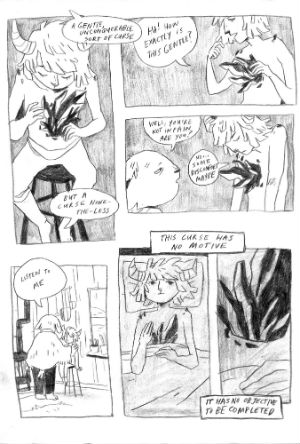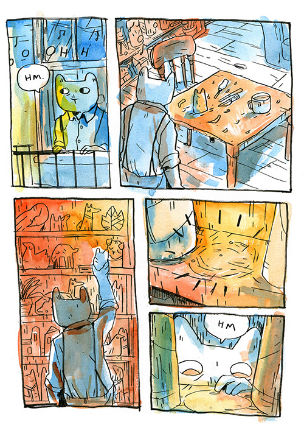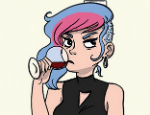B. Mure is a creator who has maintained a steady presence on the UK small press circuit over the last few years with both their own self-published comics titles and their place in anthologies like Dirty Rotten Comics and from One Beat Zines.
Earlier this month their first fuller-length graphic novel – the fantasy mystery Ismyre – debuted from Avery Hill Publishing. I described it here at Broken Frontier as “undoubtedly the breakout work of a small press creator who has long been due far greater recognition.” Today at BF, as part of our semi-regular ‘Small Press Spotlight on…‘ interviews I speak to Mure about their route into self-publishing, comics and visual metaphor, and what the future holds for the world of Ismyre…
 ANDY OLIVER: You’ve been a familiar presence on the small press circuit for a few years now but for those discovering your work for the first time through Ismyre could you give us a little background on your journey into comics to date and some of the work you’ve self-published in that time?
ANDY OLIVER: You’ve been a familiar presence on the small press circuit for a few years now but for those discovering your work for the first time through Ismyre could you give us a little background on your journey into comics to date and some of the work you’ve self-published in that time?
B. MURE: I think the first comics I ever self published were at Thought Bubble maybe 6/7 years ago? My friend Richie, who now runs my local comic shop in my home town, encouraged me and helped me sort the printing. Looking back now I kinda hate it! But it kicked off stuff. I went to art school in Bristol and despite some of my tutors telling me they hated when I put my work “in the little boxes”, I went to Bristol Zine fair a bunch and tried to make something new every time.
I did a little comic called Tiny Shoots about depression and Jeff Gordon which was a 24-hour comic about people losing everyday objects. Most recently prior to Ismyre I did a short book about an astronaut floating through space and a D&D inspired collaborative zine with two of my best friends.
You’ve contributed to a number of anthologies over the years including books from Dirty Rotten Comics (below) and One Beat Zines. How important have those group projects been in helping to build your profile through a wider sense of comics community?
It has been great to have deadlines for sure! Also I often feel pretty disconnected from the larger comics community and doing work for people where it feels a lot more tight knit and supportive is important to me (and obviously even better if you get paid). It mostly is affirming to realise that I’m not actually rubbish at the comics I do and that people relate to them in some way! I also dig it as a way of discovering other artists and writers you wouldn’t have otherwise heard of, last year I did a comic for the Sweaty Palms anthology edited by Sage Coffey which was vvvverrry good for that.
Visual metaphor and allegory have seemed an integral part of a number of your comics to date from self-published work like I Think that I Am Finally Coming Home to ‘Wilder’ in One Beat Zines’ Performance anthology (below). What would you say are the unique narrative opportunities that comics as a form provide for you personally as a storyteller?
Boy I love a visual metaphor! I have always liked the balance between what a character or caption says and what you show to people. And of course you can do that in writing too, but it is so much more apparent with images and text: you can have very soft images that are antithetical to the harsh angry words you write, or words that make no sense to the picture at all. Mostly though I think it is because if I write something I always end up imagining and drawing it anyway!
How would you describe the basic premise of Ismyre? And who makes up its cast of characters?
It is about a lonely artist in a fantastical but difficult city who keeps losing his sculptures and putting off his work. It features Ed, the artist, who is very meek and quiet, Faustine who is quite brash and fiery and doesn’t seem to have any of her own stuff to attend to, a bunch of well-dressed magical eco-anarchists and a slightly useless, self-obsessed Prime Minister which is obviously totally unlike any real life politician
This isn’t your first work for Avery Hill Publishing of course. You’ve also contributed to Ricky Miller and Julia Scheele’s Metroland series (below). How did you first become involved with AHP?
Ricky [Miller] emailed me about 5 years ago to do some Metroland commissions for him (before it was a book I think, which is funny ‘cos I knew Julia for a few years through Scriberia and didn’t realise for ages they did the book together!) You can see them here actually. So we would see each other at fairs and things and he’d say, “you should do a book!” and I’d agree but then turn myself in circles about what I should do. it wasn’t until Ricky emailed me saying “HEY do you want to pitch something” that I sent him Ismyre (but not before yelling a lot and lying on the floor with no idea what to do).
Can you tell us a little about your artistic process on Ismyre (below)? Particularly in regards to your very distinctive colour choices to evoke mood and atmosphere in the comic.
Colour used to confuse me so much. It is so frustrating. I digitally coloured for the longest time but for some reason it does my head in when it comes to comics and it was really fun to sit down and go at it with a bunch of paints (and I limited the colours to make it a lot easier for myself). I didn’t have a script, just a typed out plot really. So I’d pencil a big stack of pages and then when I got bored I’d ink them in smaller stacks and when I got bored of inking them I’d paint a stack of them and when I got bored of THAT I’d go back to pencilling them. It was a very good method for my quite short attention span.
Whether they’re set in fantastic locales like Ismyre or more mundane locations the themes of your comics often seem to be about very relatable issues like loneliness, identity and self-doubt. How central are those explorations of the human condition to your comics practice?
So central! It is so much of what I think about a lot of the time, I’m quite neurotic and hyper-sensitive and I think that approach to storytelling will stick with me for a long time! Sometimes the things you worry about being bad things are actually the things that make your storytelling interesting.
Ismyre seems like such a fully realised fictional reality already with plenty of scope for more stories set there. Do you have any plans to return to its environs in future?
Deeeeefinitely! I think it would be a shame not to (fun fact: Ismyre is based on a bunch of fantasy stories I used to imagine when I was about 15). I am already scheming.
How would you describe the growth of the ever burgeoning UK small press scene in the time you’ve been a part of it? Are there more opportunities now for self-publishers than when you first started producing your own comics?
I think it is impressive the amount of people carving out their own spaces and being able to include (and fund!) other people within it. and you would hope that those more niche spaces are more receptive and open to evolving. Also, four years ago Bristol Comic and Zine Fair was in the tiny basement of a cafe and it keeps getting bigger! There are also a lot of smaller fairs, like SHAKE in Bristol and Fair Play in Brighton popping up that feel a bit less intimidating and laid back to attend!
And, finally, are there any other comics projects you’re working on at the moment? What can we expect to see from B. Mure next?
I’m going to go back to my Boys comics and make a big old book of boys. a big old book of them. also, I am writing a lot of spooky stories for Inktober (all on my Instagram!) that I’m going to put in a wee book. ALSOOO, maybe a Morrowind zine spawned from a post-Thought Bubble pub conversation with Isaac Robin and a bunch of pals. I think that’s it maybeeeee but who knows!
For more on the work of B. Mure visit their site here and follow them on Twitter here. You can buy Ismyre from the Avery Hill Publishing online store here.
For regular updates on all things small press follow Andy Oliver on Twitter here.


























